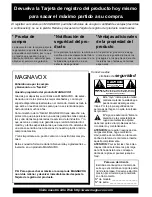
D900-13-00
1
I56-982-02
SpectrAlert Horns, Strobes, and
Horn/Strobes
For use with the following models:
Horns:
12/24 volt: H12/24*, H12/24W*
Strobes:
12 volt:
S1215, S121575, S1215W, S121575W
24 volt:
S2415*, S241575*, S2475*, S24110*, S2415W*, S241575W*,
S2475W*, S24110W*
Combo:
12 volt:
P1215, P121575, P1215W, P121575W
24 volt:
P2415*, P241575*, P2475*, P24110*, P2415W*, P241575W*,
P2475W*, P24110W*
* ULC models add suffx “A”, 24-volt models only
INSTALLATION AND MAINTENANCE INSTRUCTIONS
A Division of Pittway
3825 Ohio Avenue, St. Charles, Illinois 60174
1-800-SENSOR2, FAX: 630-377-6495
General Description
The SpectrAlert series notification appliances are designed to
meet the requirements of most agencies governing these devices,
including: NFPA, The National Fire Alarm Code, UL, ULC, FM,
CSFM, MEA. Also, check with your local Authority Having Juris-
diction for other codes or standards that may apply.
The SpectrAlert series can be installed in systems using 12- or 24-
volt panels having DC or full-wave rectified (FWR) power
supplies. The series can also be installed in systems requiring
synchronization (module MDL required) or systems that do not
require synchronization (no module required).
NOTICE:
This manual should be left with the owner/user of this
equipment.
Fire Alarm System Considerations
Temporal and Non-Temporal Coded Signals:
The American National Standards Institute and the National Fire
Alarm Code require that all horns used for building evacuation
installed after July 1, 1996, must produce Temporal Coded Signals.
Signals other than those used for evacuation purposes do not have
to produce the Temporal Coded Signal. Temporal coding is accom-
plished by interrupting a steady sound in the following manner:
1/2 Sec.
On
1/2 Sec.
Off
1/2 Sec.
On
1/2 Sec.
Off
1/2 Sec.
On
1-1/2 Sec.
Off
Repeats
Specifications
Voltage Range:
DC or Full-Wave Rectified
(CAUTION: H12/24(A) and H12/24W(A) will not operate on coded power supplies.)
Horn: 10.5 to 30 Volts; H12/24A and H12/24WA (ULC) 20 to 30 volts
Strobes & Horn/Strobes: 12-volt models–10.5 to 17 volts; 24-volt models–20 to 30 volts
Flash Rate:
1 Flash Per Second
Operating Temperature:
32˚ F to 120˚ F (0˚ C to 49˚ C)
Light Output:
Models with 15 only in the model number are listed at 15 candela
Models with 1575 are listed at 15 candela per UL 1971 but will provide 75 candela on axis (straight ahead)
Models with 75 are listed at 75 candela
Models with 110 are listed at 110 candela
Sound Output:
Sound output levels are established at Underwriters Laboratories in their reverberant room. Always use
the sound output specified as UL Reverberant Room when comparing products.
Listings:
UL S4011 (Horns and Horn/Strobes), UL S5512 (Strobes)
ULC CS548 (Horns), ULC CS549 (Strobes and Horn/Strobes)
Factory Mutual
Power Supply Considerations
Panels typically supply DC filtered voltage or FWR (full-wave rec-
tified) voltage. The system design engineer must calculate the
number of units used in a zone based on the type of panel supply.
Be certain the sum of all the device currents do not exceed the
current capability of the panel. Calculations are based on using
the device current found in the subsequent charts and must be the
current specified for the type of panel power supply used.
Wire Sizes
The designer must be sure that the last device on the circuit has
sufficient voltage to operate the device within its rated voltage.
When calculating the voltage available to the last device, it is nec-
essary to consider the voltage drop due to the resistance of the
wire. The thicker the wire, the less the voltage drop. Generally,
for purposes of determining the wire size necessary for the sys-
tem, it is best to consider all of the devices as “lumped” on the
end of the supply circuit (simulates “worst case”).
Typical wire size resistance:
18 AWG solid:
Approximately 8 ohms/1,000 ft.
16 AWG solid:
Approximately 5 ohms/1,000 ft.
14 AWG solid:
Approximately 3 ohms/1,000 ft.
12 AWG solid:
Approximately 2 ohms/1,000 ft.
Example: Assume you have 10 devices on a zone and each re-
quires 50 mA average and 2000 Ft. of 14 AWG wiring (total
length=oureturn). The voltage at the end of the loop is
0.050 amps per device x 10 devices x 3 ohms/1,000 ft. x 2000 ft
=3 volts drop.
Technical Manuals Online! - http://www.tech-man.com




























